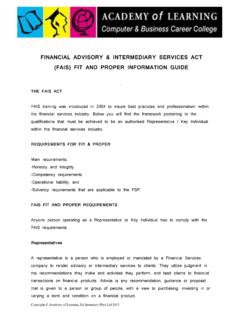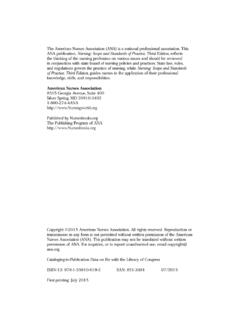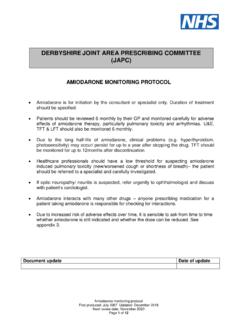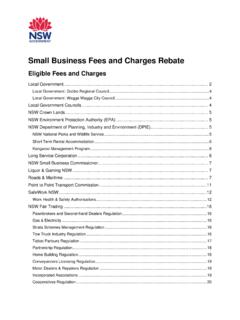Transcription of Skill mix in the health care workforce: reviewing the evidence
1 Skill mix in the health care workforce : reviewing the evidenceJames Buchan1& Mario R. Dal Poz2 AbstractThis paper discusses the reasons for Skill mix among health workers being important for health systems. It examines theevidence base (identifying its limitations), summarizes the main findings from a literature review, and highlights the evidence on Skill mixthat is available to inform health system managers, health professionals, health policy-makers and other stakeholders. Many publishedstudies are merely descriptive accounts or have methodological weaknesses. With few exceptions, the published analytical studies wereundertaken in the USA, and the findings may not be relevant to other health systems. The results from even the most rigorous of studiescannot necessarily be applied to a different setting.
2 This reflects the basis on which Skill mix should be examined identifying the careneeds of a specific patient population and using these to determine the required skills of staff. It is therefore not possible to prescribe indetail a universal ideal mix of health personnel. With these limitations in mind, the paper examines two main areas in whichinvestigating current evidence can make a significant contribution to a better understanding of Skill the mix of nursing staff, the evidence suggests that increased use of less qualified staff will not be effective in all situations,although in some cases increased use of care assistants has led to greater organizational effectiveness. evidence on the doctor nurseoverlap indicates that there is unrealized scope in many systems for extending the use of nursing staff.
3 The effectiveness of different skillmixes across other groups of health workers and professions, and the associated issue of developing new roles remain relatively personnel; Clinical competence; Personnel staffing and scheduling; Patient care team; Nursing staff; Physicians;Allied health personnel/utilization; Professional role; Review literature; Meta-analysis (source: MeSH, NLM).Mots cle sPersonnel sanitaire; Compe tence clinique; Affectation personnel et organisation temps travail; Equipe soignante; Personnelinfirmier; Me decin; Personnel parame dical/utilisation; Ro le professionnel; Revue de la litte rature; Me ta-analyse (source: MeSH, INSERM).Palabras clavePersonal de salud; Competencia cl nica; Admisio n y programacio n de personal; Grupo de atencio n al paciente; Personalde enfermer a; Me dicos; Te cnicos medios en salud/utilizacio n; Rol profesional; Literatura de revisio n; Meta-ana lisis (fuente: DeCS, BIREME).
4 Bulletin of the World health Organization 2002;80 page 579 le re sume en franc ais. En la pa gina 579 figura un resumen en espan World health Report 2000noted that determining andachieving the right mix of health personnel are majorchallenges for most health care organizations and healthsystems (1). health care is labour-intensive and managers ofhealth care provider units strive to identify the most effectivemix of staff that can be achieved with the available resources,taking into consideration local term Skill mix is usually used to describe the mix ofposts, grades or occupations in an organization (strictlyspeaking, this is more accurately referred to as grade mix ).It may also refer to the combinations of activities or skillsneeded for each job within the organization.
5 This paper gives abrief overview of the determining factors that should be takeninto consideration when assessing and adjusting Skill mix. Itthen summarizes the main findings from a literature review,highlighting the evidence on Skill mix that is available to informhealth system managers, health professionals, health policy-makers and other is no common starting point for examining skillmix in different countries, sectors and health availability, regulatory environments, culture, cus-tom and practice will all have played a role in determining thetypical or normal mix of staff in a particular health system. Tothe extent that these factors vary, so will the typical mix. Indeedthere are marked variations between countries and regions interms of the mix of health care occupations (2).
6 Table 1highlights some of the key considerations that explain why skillmix is important in many health systems (3).The factors that generate pressure for change in the skillmix are not mutually exclusive, and changing the Skill mix is notthe only option for responding to them. Employing organiza-tions should also review other possibilities, such as improvingthe use of hospital beds, capital equipment and otherresources; improving staffing patterns in relation to day-to-day fluctuations in workload and patient dependency; andadjusting the distribution of resources ( between tertiary,secondary and primary care ). reviewing Skill mixOur review of publications examining Skill mix in health carewas based on two literature searches. The first was undertakenfor the World health Organization (WHO), and focused onEnglish-language material published between 1986 and 1996found through CINAHL, Medline, RCN Nurse ROM, ASSIAPlus, and FirstSearch (4).
7 The second comprised a follow-upsearch of English-language material published in the period1996 2000 through CINAHL, Medline, ASSIA and Nurse1 Faculty of Social Sciences and health care , Queen Margaret University College, Clerwood Terrace, Edinburgh, Scotland, EH12 8TS (email: Department of Heath Service Provision, World health Organization, Geneva, of the World health Organization 2002, 80 (7)Online. The search terms used were: Skill mix , skillsubstitution , personnel mix , reprofiling , staffing levels ,and staffing mix . The term changing roles was alsoincluded for the second review indicated a growing interest in Skill mix, withmore than twice as many publications recorded for the period1996 2000 as for the previous 10 years (1986 96). The mainfindings are grouped as follows: reviews and meta-analyses;large-scale ( macro ) data surveys; single-site ( micro )examinations of roles and mix in nursing and other non-medical health professions; single-site ( micro ) examinationsof role overlap between doctors and other health professionals;and studies on introductions of new types of are several limitations to the review.)
8 First, theremay be publication bias, because unsuccessful attempts atchanging Skill mix may be less likely to be recorded andpublished. Second, searches rely on the use of key words; skillmix is covered by a broad range of possible key words, andsome relevant publications may have been missed. Third, mostof the publications reviewed are in English; this will lead to biasin terms of the countries and health systems being particular, the majority of the publications are from theUSA, where the health system is predominantly in the privatesector and there is a free-market approach to employmentlegislation and job and meta-analysesThe small number of meta-analyses includes two NorthAmerican papers that focus on doctor nurse roles and overlap(5,6). Two international reviews (drawing heavily on UnitedStates sources) have recently been undertaken in the UnitedKingdom (4,7), along with a review focusing specifically on thedoctor nurse mix in primary care (8).
9 While meta-analyses support a more conclusive over-view than can be drawn from individual studies, they havelimitations when applied to a context-bound issue such as theassessment of Skill mix. The meta-analyses reviewed revealevidence (mainly but not exclusively from the United States)that, in settings where there is actual or potential role overlapbetween registered nurses and doctors, there is scope for acost-effective increase in the role and deployment of theformer. In particular, the use of clinical nurse specialists, nursepractitioners and clinical nurse midwives can improve careoutcomes (often measured by patient satisfaction), whilemaintaining or reducing ( macro ) data surveysThese studies assess large datasets, often from multiple sites, todetermine the extent to which variations in measures ofoutcome can be attributed to differences in staffing level orstaffing mix.
10 As with meta-analyses, the majority of thesestudies have been conducted in the USA. Recent reports aresummarized in Table 2 (9 11).These large-scale analyses of secondary data can givesome insight into the relation between staffing level or mixand indicators of cost or quality. They can also providepotential benchmarks for employing organizations, see, forexample, the discussion of the early stages of a multicountrycomparative study (12,13), a multicountry study examiningthe extent of use of trained nurses and overall resource usein long -term care in England, Japan, Sweden, Spain and theUSA (14), and a multicountry analysis of variations in doctor nurse ratios (15).While large-scale surveys have the potential to increaseour understanding of the complex relationships betweenstaffing, cost and outcome variables, they have two mainweaknesses.

















